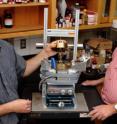Iowa State chemists discover method to create high-value chemicals from biomass
Iowa State University researchers have found a way to produce high-value chemicals such as ethylene glycol and propylene glycol from biomass rather than petroleum sources. Walter Trahanovsky, an Iowa State professor of chemistry who likes to write out the chemical structures of compounds when he talks about his science, was looking to produce sugar derivatives from cellulose and other forms of biomass using high-temperature chemistry. And so he and members of his research group studied the reactions of cellulosic materials in alcohols at high temperatures and pressures.
They analyzed the products of the reactions using nuclear magnetic resonance spectroscopy. Early experiments produced the expected sugar derivatives. Additional work, however, clearly revealed significant yields of ethylene glycol and propylene glycol.
"It was a real surprise," Trahanovsky said. "These products were unexpected, so we never looked for them. But they were always there."
Uses for ethylene glycol include auto antifreeze, polyester fabrics and plastic bottles. Propylene glycol has many uses, including as a food additive, a solvent in pharmaceuticals, a moisturizer in cosmetics and as a coolant in liquid cooling systems.
Conversion of biomass to fuels and other chemicals can require strong acids or other harsh and expensive compounds. These processes also generate chemical wastes that have to be collected for safe disposal.
The Iowa State researchers say they have found a technology that is simpler yet effective and also better for the environment.
"There is potential here," said Trahanovsky. "It's not a wild dream to think this could be developed into a practical process."
The biomass conversion process is based on the chemistry of supercritical fluids, fluids that are heated under pressure until their liquid and gas phases merge. In this case, Trahanovsky said the key results are significant yields of ethylene glycol, propylene glycol and other chemicals with low molecular weights. He said the process also produces alkyl glucosides and levoglucosan that can be converted into glucose for ethanol production or other uses.
All this happens without the use of any expensive reagents such as acids, enzymes, catalysts or hydrogen gas, Trahanovsky said. The process even works when there are impurities in the biomass.
The Iowa State University Research Foundation Inc. has filed for a patent of the technology.
The research has been supported by grants from the Iowa Energy Center. Other Iowa State researchers who have contributed to the project include Ronald Holtan, a postdoctoral research associate in chemistry; Norm Olson, the project manager of the Iowa Energy Center's BECON facility near Nevada; Joseph Marshall, a former graduate student; and Alyse Hurd and Kyle Quasdorf, former undergraduate students.
Trahanovsky said the research team is still working to develop and improve the conversion technology.
And he does think the technology could be useful to industry.
"The starting materials for this are cheap," Trahanovsky said. "And the products are reasonably high-value chemicals."
Source: Iowa State University
Other sources
- Chemists Discover Method to Create High-Value Chemicals from Biomassfrom Newswise - Scinews14 years ago
- Chemists discover method to create high-value chemicals from biomassfrom Physorg14 years ago
- Iowa State chemists discover method to create high-value chemicals from biomassfrom Science Blog14 years ago


